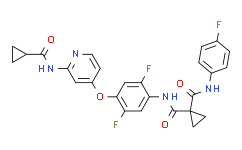| Description: |
Altiratinib (DCC-2701) is a multi-targeted kinase inhibitor with IC50s of 2.7, 8, 9.2, 9.3, 0.85, 4.6, 0.83 nM for MET, TIE2, VEGFR2, FLT3, Trk1, Trk2, and Trk3 respectively. |
| In Vivo: |
A single oral dose of 30 mg/kg Altiratinib leads to >95% inhibition of MET phosphorylation for the entire 24-hour period. A single 10 mg/kg oral dose of Altiratinib exhibits complete inhibition of MET phosphorylation through 12 hours and 73% inhibition at 24 hours postdose. Altiratinib dosed at 10 mg/kg twice a day leads to a significant 90% decrease in BLI signal. Altiratinib exhibits properties amenable to oral administration and exhibits substantial blood–brain barrier penetration, an attribute of significance for eventual treatment of brain cancers and brain metastases[1]. |
| In Vitro: |
Altiratinib also inhibits MET isoforms METD1228H, MET D1228N, METY1230C, METY1230D, METY1230H, METM1250T with IC50s of 3.6, 1.3, 1.2, 0.37, 1.5 and 6 nM, respectively. Altiratinib inhibits MET phosphorylation with IC50 values of 0.85 and 2.2 nM, respectively. In the U-87 glioblastoma cell line, MET and HGF are both expressed. Altiratinib blocks autocrine activation of MET phosphorylation in these cells (IC50=6.2 nM). Altiratinib potently inhibits cellular proliferation in MET-amplified EBC-1 and MKN-45 cells, as well as TPM3-TRKA fusion KM-12 cells. Activation of MET is known to increase the motility and invasiveness of cancer cells: Altiratinib inhibits HGF-induced A549 cell migration, with an IC50 of 13 nM. Altiratinib also inhibits FLT3-ITD mutant MV-4-11 cell proliferation with an IC50 of 12 nM[1]. |
| Cell Assay: |
Altiratinib is dispensed into assay plates. Cells are added to 96-well (EBC-1, M-NFS-60, and SK-MEL-28: 2,500 cells/well; MKN-45: 5,000 cells/well; MV-4-11: 10,000 cells/well) or 384-well plates (A375 and HCT-116: 625 cells/well; BT-474, KM-12, PC-3, and U-87-MG: 1,250 cells/well). Plates are incubated for 72 hours. Viable cells are quantified using resazurin using a plate reader with excitation at 540 nm and emission at 600 nm[1]. |
| Animal Administration: |
Mice: Female nude mice are inoculated subcutaneously. On days 9 to 10, when tumor volumes reached 326 mg on average, mice are randomly assigned to groups and dosed once orally with 0.4% HMPC, (n=3); Altiratinib at 30 mg/kg (n=21); or Altiratinib at 10 mg/kg (n=21). At specified time points, whole blood and tumors are collected. Pharmacokinetic analysis is performed. Tumor samples are processed in the Western blot assay methods[1]. |
| References: |
[1]. Smith BD, et al. Altiratinib Inhibits Tumor Growth, Invasion, Angiogenesis, and Microenvironment-Mediated DrugResistance via Balanced Inhibition of MET, TIE2, and VEGFR2. Mol Cancer Ther. 2015 Sep;14(9):2023-34. |

 To enhance service speed and avoid tariff delays, we've opened a US warehouse. All US orders ship directly from our US facility.
To enhance service speed and avoid tariff delays, we've opened a US warehouse. All US orders ship directly from our US facility.




















